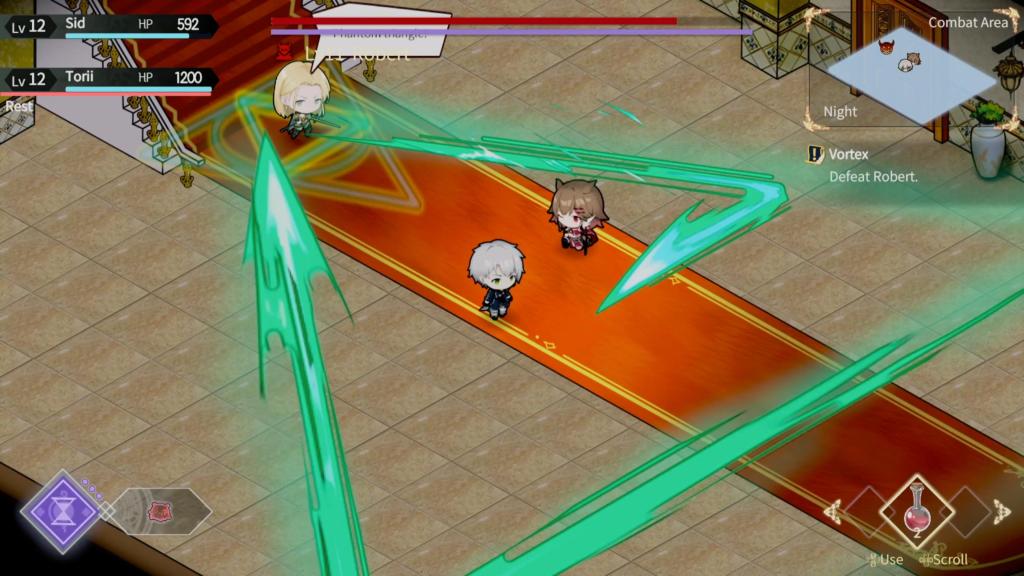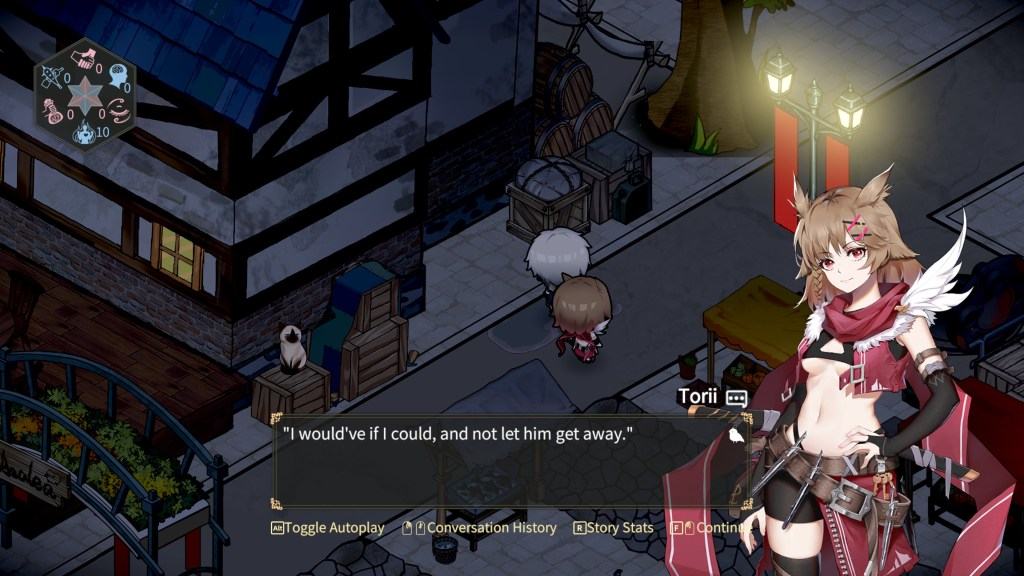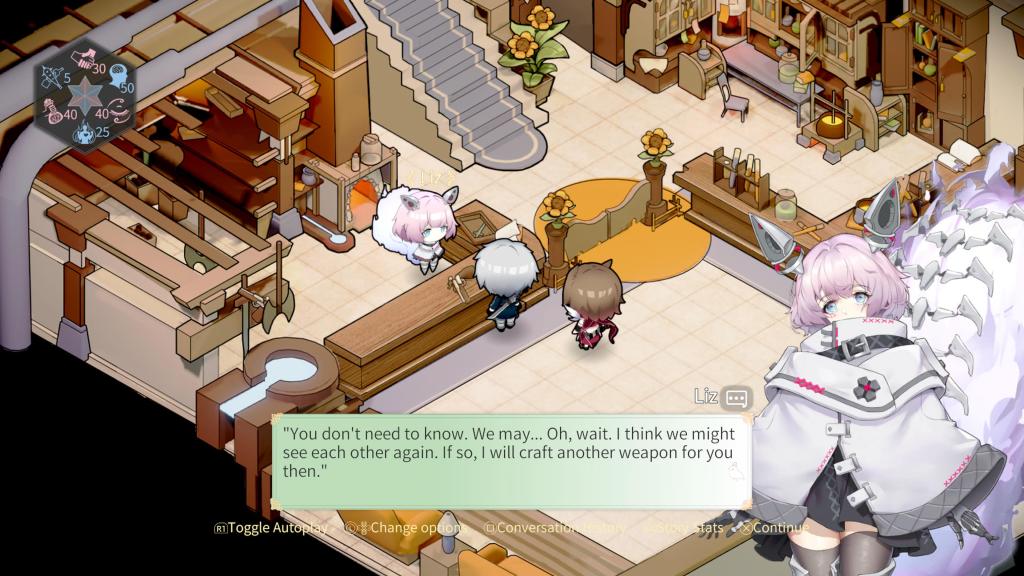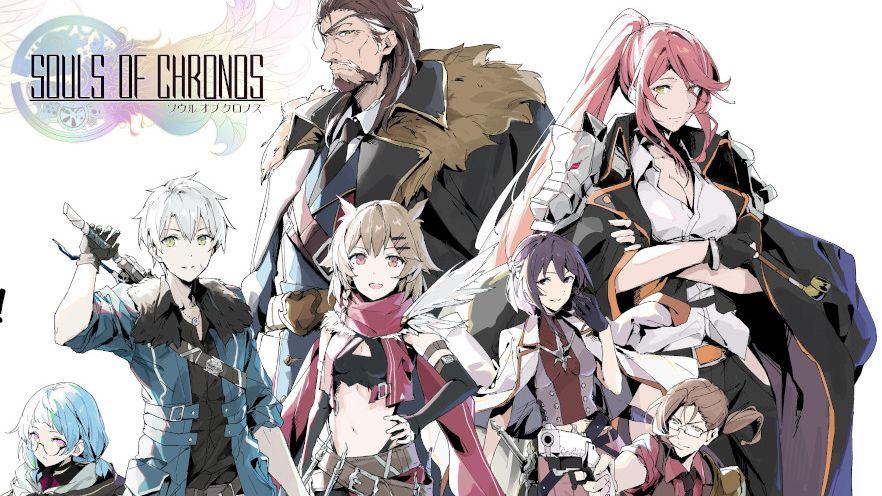Contents
- 1 Review: Souls of Chronos
- 1.1 A Brief History of Time
- 1.2 Time’s Arrow (and Gun and Sword)
- 1.3 The Time Traveler’s Portrait
- 1.4 Time After Time After Time
- 1.5 ~ Final Score: 6/10 ~
- 1.6 A Brief History of Time
- 1.7 Time’s Arrow (and Gun and Sword)
- 1.8 The Time Traveler’s Portrait
- 1.9 Time After Time After Time
- 1.10 ~ Final Score: 6/10 ~
Review: Souls of Chronos
One of the things that’s kind of amazing about reviewing games is the fact that you see things you otherwise probably would never have caught. Souls of Chronos is just such a game. It’s a little indie game from Shanghai-based FUTU Studio, published by Astrolabe Games, and the odds are pretty good that it wouldn’t have ever caught my eye if I hadn’t picked it up for review. That is kind of wild to think about it, that there are so many games and it’s so easy to lose track of them.
But what does that have to do with the game itself, you ask? Well, sometimes intros are hard to write. But now you, too, know that Souls of Chronos is coming out today, February 14th, for PC, PlayStation 5, and Nintendo Switch. Is that knowledge you should commit to your memory and give it a look on your platform of choice? Or are you better served by letting it slip out of your memory altogether? That’s what we’re going to spend this review discussing, so let’s find out. The PC version was played for this review, for the record.

A Brief History of Time
At its heart, Souls of Chronos is the story of a tremendous wiener named Sid – see, I did it, I did the joke again. But it’s not actually fair. Sid does appear to be suffering from a mild case of Shonen Anime Protagonist, but with proper treatment, some medication, and avoiding any waifish girls with pale blue or bright red hair whom he finds unconscious, he can likely live a full life. Also, he has his soul already bonded to a Chronus named Torii, so that puts him ahead of the game.
“Wait, what’s a Chronus?” Well… I’d love to tell you, but the game has the problem of how it presents its lore. They’re sort of related to a big cataclysmic event from fifteen years ago that wreaked major changes on the world, but everything is kind of hard to parse and underexplained. What you need to know is that she’s a magical being subsisting on his remaining lifespan, but she’s also powerful and a big help to him as he does things, so it’s best to just accept it and move on. Just like the other underexplained non-human races and such.
Look, the important thing is that you’ve seen a fantasy city before. And here in the dockside city of Astella, you have one you’re pretty familiar with. Sid, however, is not a bright-eyed kid from a humble background; he’s part of the Hyenas, a gang that generally runs the city and keeps some semblance of order on the streets. Unfortunately, the Hyenas are starting to be forced out by the arrival of the Antelope, and someone – likely connected to the rival gang – is killing Hyenas. And there are a lot of politics going on.
I’m not going to front, the story hooked me a little more because Sid is unambiguously a gangster. The game tells you as much, and while you can alter his demeanor a lot, at the end of the day he is not a good guy in the traditional sense. He’s just the better one. Your first quest does have you extorting someone, after all. That gives an added bit of spice to the proceedings, a sense that rather than coming in from the outside this is a person occupying a lived-in world. I do wish that the game was a bit better about bringing you into that world a bit faster, but…
Well, some of that might also come down to the fact that as you might expect from a small indie game created by a Shanghai studio, the translation has some rather interesting approaches to English grammar and diction. We’ll come back to that later.

Time’s Arrow (and Gun and Sword)
The core of Souls of Chronos is its gameplay, which is clearly meant to be a pretty standard hack-and-slash affair with Torii and Sid. Sid can use a variety of guns and swords, while Torii has her own particular techniques and cannot be directly controlled. Both of them can be customized, though, Sid through his equipment and upgrades to same, and Torii through how you place her skill points after each level up.
The interesting thing is that the game’s length shows through the fairly limited list of upgrades, skills, and so forth. It’s easy to feel like the Astella stuff is a prelude to the real game, but no, this is the real game. However, this isn’t a weakness but a designed element; the game seems to be built strongly on the idea that if you give players a small number of impactful decisions early on and let them build from there, it’s going to be both more resonant and more satisfying than realizing you should have made a different choice 30 hours ago in a 40-hour game.
Here’s the main problem with combat, sadly… it’s kind of boring. You run up to your enemy with a melee weapon or run away with a ranged weapon, attack over and over until they die. Numbers go up or down. Nothing particularly interesting happens beyond that, and if you’ve played any sort of hack-and-slash game this will be not only familiar but rote. For a hack-and-slash game, this is probably not a great place for it to be.
Either in awareness of this or in spite of it, the game offers you a lot of stuff to do outside of combat. Both Sid and Torii have personality traits that are influenced by the choices you make in conversations; you can make Sid more of a violent hot-blooded sort or more prone to thinking and considering. They’re not huge changes, but they unlock different dialogue choices and different ways of dealing with the world. Torii also becomes more prone to doing things like stealing items, or noticing unknown elements. It’s a nice extra layer to customization.
The game only has four endings, but between the short length on a whole and the fact that (as mentioned) the game is more based around a few meaningful choices than a lot of choices padding things out, it’s not a chore to replay and see what you missed. Heck, you even have more options for how to try a different weapon or skill progression this time around. That’s nice and it works out well; it’s a pity that the combat, as mentioned, is a bit on the bland side.

The Time Traveler’s Portrait
I’m not really a fan of the art style. It feels… overly flat in most places other than character portraits, but the uncomfortable result is that the character portraits look out of place on a whole. Actual characters pop out from the background to an uncomfortable degree, too, so it feels like the characters themselves are being shoehorned into a game that they weren’t made for.
While the music is nothing to write home about, the sound design is quite well-done. Footsteps echo appropriately, swings and impacts feel meaty and substantive, and I generally enjoyed listening to moving through and interacting with the world. I also liked that the designers did add nice little effects throughout the game, like little visual flair for character footsteps or opening things. It’s a small touch, but I noticed it and I liked it.
I also managed to encounter a few bugs, but some of them are already flagged by the developers for fixing, so it’s clear the team has been working overtime to get everything in order. Sometimes the game isn’t great about picking out when you’re in range to interact with an NPC or an object, though, and there was at least one bug where I accidentally glitched myself past a gate and couldn’t get back on the other side to progress the story. Save often.
Speaking of the story, the translation is… well, it’s not dire. It’s generally competent and it feels like it was done to a level wherein everything is readable. But there are some obvious grammatical bits of weirdness, descriptions that seem to be repeated at odd times, characters delivering lines that are supposed to be attributed to others, and so forth. Sometimes it just becomes hard to understand, like when a dialogue option is just “Are those…?” without indicating what “those” might be, or “What reality am I living in?” as a question to ask someone you just met.
Basically, if you want to enjoy the story, be prepared to do a bit of odd translation lifting. It’s not the worst translated game I’ve even played this year, but it isn’t great.

Time After Time After Time
The thing about Souls of Chronos is that I don’t dislike it. It’s not a bad game. The combat is a bit lightweight, but I feel like it’s at least not bad. The story is a bit harder to understand than it needs to be, but it has parts I like. There are artistic touches I like mixed with ones I don’t. Shot through the whole thing is definitely a sense of enthusiasm, like the people involved are really happy to have made a video game and it might be a sloppy, lopsided mess, but they’re proud of it, darn it.
And they should be! They made a video game at a low price. But it does mean in evaluating it I kind of find myself deciding whether it errs toward being a lower-rated game with a recommendation or a higher-rated game without one. And I ultimately feel like the former is closer to where it deserves to be.
Souls of Chronos is a sloppy and in some ways surprisingly wane little thing, a bunch of ideas that don’t ever fully coalesce into a satisfying whole, but there is a value in that. If dodgy translation, somewhat bland combat, and an erratic art style don’t dissuade you? You’re going to have fun with it. I had fun with it. But I also had fun with it while wishing it were just a little more cohesive, a little more polished.
I don’t regret giving Souls of Chronos my time, exactly, but I wish it had been a little more appreciative in turn.
~ Final Score: 6/10 ~
Review copy provided by Astrolabe Games for PC. Screenshots courtesy of Astrolabe Games and the reviewer.
Search for:

One of the things that’s kind of amazing about reviewing games is the fact that you see things you otherwise probably would never have caught. Souls of Chronos is just such a game. It’s a little indie game from Shanghai-based FUTU Studio, published by Astrolabe Games, and the odds are pretty good that it wouldn’t have ever caught my eye if I hadn’t picked it up for review. That is kind of wild to think about it, that there are so many games and it’s so easy to lose track of them.
But what does that have to do with the game itself, you ask? Well, sometimes intros are hard to write. But now you, too, know that Souls of Chronos is coming out today, February 14th, for PC, PlayStation 5, and Nintendo Switch. Is that knowledge you should commit to your memory and give it a look on your platform of choice? Or are you better served by letting it slip out of your memory altogether? That’s what we’re going to spend this review discussing, so let’s find out. The PC version was played for this review, for the record.

A Brief History of Time
At its heart, Souls of Chronos is the story of a tremendous wiener named Sid – see, I did it, I did the joke again. But it’s not actually fair. Sid does appear to be suffering from a mild case of Shonen Anime Protagonist, but with proper treatment, some medication, and avoiding any waifish girls with pale blue or bright red hair whom he finds unconscious, he can likely live a full life. Also, he has his soul already bonded to a Chronus named Torii, so that puts him ahead of the game.
“Wait, what’s a Chronus?” Well… I’d love to tell you, but the game has the problem of how it presents its lore. They’re sort of related to a big cataclysmic event from fifteen years ago that wreaked major changes on the world, but everything is kind of hard to parse and underexplained. What you need to know is that she’s a magical being subsisting on his remaining lifespan, but she’s also powerful and a big help to him as he does things, so it’s best to just accept it and move on. Just like the other underexplained non-human races and such.
Look, the important thing is that you’ve seen a fantasy city before. And here in the dockside city of Astella, you have one you’re pretty familiar with. Sid, however, is not a bright-eyed kid from a humble background; he’s part of the Hyenas, a gang that generally runs the city and keeps some semblance of order on the streets. Unfortunately, the Hyenas are starting to be forced out by the arrival of the Antelope, and someone – likely connected to the rival gang – is killing Hyenas. And there are a lot of politics going on.
I’m not going to front, the story hooked me a little more because Sid is unambiguously a gangster. The game tells you as much, and while you can alter his demeanor a lot, at the end of the day he is not a good guy in the traditional sense. He’s just the better one. Your first quest does have you extorting someone, after all. That gives an added bit of spice to the proceedings, a sense that rather than coming in from the outside this is a person occupying a lived-in world. I do wish that the game was a bit better about bringing you into that world a bit faster, but…
Well, some of that might also come down to the fact that as you might expect from a small indie game created by a Shanghai studio, the translation has some rather interesting approaches to English grammar and diction. We’ll come back to that later.

Time’s Arrow (and Gun and Sword)
The core of Souls of Chronos is its gameplay, which is clearly meant to be a pretty standard hack-and-slash affair with Torii and Sid. Sid can use a variety of guns and swords, while Torii has her own particular techniques and cannot be directly controlled. Both of them can be customized, though, Sid through his equipment and upgrades to same, and Torii through how you place her skill points after each level up.
The interesting thing is that the game’s length shows through the fairly limited list of upgrades, skills, and so forth. It’s easy to feel like the Astella stuff is a prelude to the real game, but no, this is the real game. However, this isn’t a weakness but a designed element; the game seems to be built strongly on the idea that if you give players a small number of impactful decisions early on and let them build from there, it’s going to be both more resonant and more satisfying than realizing you should have made a different choice 30 hours ago in a 40-hour game.
Here’s the main problem with combat, sadly… it’s kind of boring. You run up to your enemy with a melee weapon or run away with a ranged weapon, attack over and over until they die. Numbers go up or down. Nothing particularly interesting happens beyond that, and if you’ve played any sort of hack-and-slash game this will be not only familiar but rote. For a hack-and-slash game, this is probably not a great place for it to be.
Either in awareness of this or in spite of it, the game offers you a lot of stuff to do outside of combat. Both Sid and Torii have personality traits that are influenced by the choices you make in conversations; you can make Sid more of a violent hot-blooded sort or more prone to thinking and considering. They’re not huge changes, but they unlock different dialogue choices and different ways of dealing with the world. Torii also becomes more prone to doing things like stealing items, or noticing unknown elements. It’s a nice extra layer to customization.
The game only has four endings, but between the short length on a whole and the fact that (as mentioned) the game is more based around a few meaningful choices than a lot of choices padding things out, it’s not a chore to replay and see what you missed. Heck, you even have more options for how to try a different weapon or skill progression this time around. That’s nice and it works out well; it’s a pity that the combat, as mentioned, is a bit on the bland side.

The Time Traveler’s Portrait
I’m not really a fan of the art style. It feels… overly flat in most places other than character portraits, but the uncomfortable result is that the character portraits look out of place on a whole. Actual characters pop out from the background to an uncomfortable degree, too, so it feels like the characters themselves are being shoehorned into a game that they weren’t made for.
While the music is nothing to write home about, the sound design is quite well-done. Footsteps echo appropriately, swings and impacts feel meaty and substantive, and I generally enjoyed listening to moving through and interacting with the world. I also liked that the designers did add nice little effects throughout the game, like little visual flair for character footsteps or opening things. It’s a small touch, but I noticed it and I liked it.
I also managed to encounter a few bugs, but some of them are already flagged by the developers for fixing, so it’s clear the team has been working overtime to get everything in order. Sometimes the game isn’t great about picking out when you’re in range to interact with an NPC or an object, though, and there was at least one bug where I accidentally glitched myself past a gate and couldn’t get back on the other side to progress the story. Save often.
Speaking of the story, the translation is… well, it’s not dire. It’s generally competent and it feels like it was done to a level wherein everything is readable. But there are some obvious grammatical bits of weirdness, descriptions that seem to be repeated at odd times, characters delivering lines that are supposed to be attributed to others, and so forth. Sometimes it just becomes hard to understand, like when a dialogue option is just “Are those…?” without indicating what “those” might be, or “What reality am I living in?” as a question to ask someone you just met.
Basically, if you want to enjoy the story, be prepared to do a bit of odd translation lifting. It’s not the worst translated game I’ve even played this year, but it isn’t great.

Time After Time After Time
The thing about Souls of Chronos is that I don’t dislike it. It’s not a bad game. The combat is a bit lightweight, but I feel like it’s at least not bad. The story is a bit harder to understand than it needs to be, but it has parts I like. There are artistic touches I like mixed with ones I don’t. Shot through the whole thing is definitely a sense of enthusiasm, like the people involved are really happy to have made a video game and it might be a sloppy, lopsided mess, but they’re proud of it, darn it.
And they should be! They made a video game at a low price. But it does mean in evaluating it I kind of find myself deciding whether it errs toward being a lower-rated game with a recommendation or a higher-rated game without one. And I ultimately feel like the former is closer to where it deserves to be.
Souls of Chronos is a sloppy and in some ways surprisingly wane little thing, a bunch of ideas that don’t ever fully coalesce into a satisfying whole, but there is a value in that. If dodgy translation, somewhat bland combat, and an erratic art style don’t dissuade you? You’re going to have fun with it. I had fun with it. But I also had fun with it while wishing it were just a little more cohesive, a little more polished.
I don’t regret giving Souls of Chronos my time, exactly, but I wish it had been a little more appreciative in turn.
~ Final Score: 6/10 ~
Review copy provided by Astrolabe Games for PC. Screenshots courtesy of Astrolabe Games and the reviewer.